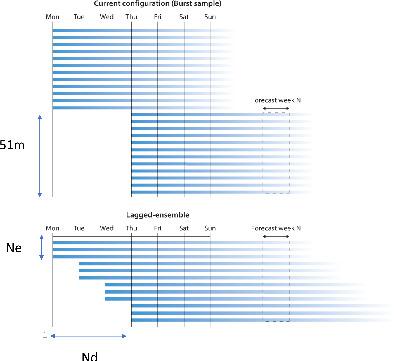当前位置:
X-MOL 学术
›
Q. J. R. Meteorol. Soc.
›
论文详情
Our official English website, www.x-mol.net, welcomes your
feedback! (Note: you will need to create a separate account there.)
Lagged ensembles in sub-seasonal predictions
Quarterly Journal of the Royal Meteorological Society ( IF 3.0 ) Pub Date : 2021-07-12 , DOI: 10.1002/qj.4125 Frédéric Vitart 1 , Yuhei Takaya 2
Quarterly Journal of the Royal Meteorological Society ( IF 3.0 ) Pub Date : 2021-07-12 , DOI: 10.1002/qj.4125 Frédéric Vitart 1 , Yuhei Takaya 2
Affiliation

|
The benefits of using lagged ensembles for S2S predictions have been evaluated using the ECMWF sub-seasonal to seasonal (S2S) forecasts. The ECMWF S2S forecasts are currently produced twice a week from a 51-member ensemble. An experiment where the ECMWF forecasts are produced daily instead of twice weekly has been performed to identify the minimum lagged-ensemble configuration which will produce probabilistic forecasts at least as skilful as the current configuration. Results suggest that the extended-range prediction of the Madden–Julian Oscillation (MJO) is not deteriorated with the daily lagged ensemble approach, but there is a slight degradation during the first 10 days. In the northern Extratropics, the probabilistic skill scores are improved after week 2 when using lagged ensembles, but only if the daily ensemble size exceeds 20 members. The lagged ensemble approach is more beneficial in the Tropics than in the northern Extratropics, showing even benefits in forecast week 1 over the Tropics, despite the 24 hr difference between two consecutive forecasts. As expected, the daily lagged ensemble method is more beneficial for longer lead times and the optimal lagged ensemble window increases from 2 days for week 2 to 4 days for week 4. An idealized numerical simulation, based on a Monte Carlo approach, confirms the benefits of lagged ensembles. The results obtained are generally consistent with the ECMWF forecast experiment, suggesting that such a simulation could be used as a cheap alternative to address the benefit of lagged versus burst ensembles.
中文翻译:

次季节预测中的滞后集合
已经使用 ECMWF 次季节到季节 (S2S) 预测评估了使用滞后集合进行 S2S 预测的好处。ECMWF S2S 预测目前每周由 51 个成员组成的集合生成两次。已经进行了一项实验,其中 ECMWF 预测每天生成而不是每周两次,以确定最小滞后集合配置,该配置将产生至少与当前配置一样熟练的概率预测。结果表明,麦登-朱利安振荡 (MJO) 的扩展范围预测并未因每日滞后集合方法而恶化,但在前 10 天内略有下降。在北温带地区,当使用滞后集合时,概率技能分数在第 2 周后有所提高,但前提是每日集合规模超过 20 名成员。滞后集合方法在热带地区比在北温带地区更有利,尽管两次连续预报之间存在 24 小时的差异,但在第 1 周的预报中甚至显示出对热带地区的益处。正如预期的那样,每日滞后集成方法对更长的提前期更有利,最佳滞后集成窗口从第 2 周的 2 天增加到第 4 周的 4 天。基于蒙特卡罗方法的理想化数值模拟证实了这些好处的滞后集合。获得的结果与 ECMWF 预测实验基本一致,表明这种模拟可以作为一种廉价的替代方案来解决滞后与突发集合的优势。尽管两次连续预测之间存在 24 小时差异,但在预测第 1 周对热带地区的收益甚至更高。正如预期的那样,每日滞后集成方法对更长的提前期更有利,最佳滞后集成窗口从第 2 周的 2 天增加到第 4 周的 4 天。基于蒙特卡罗方法的理想化数值模拟证实了这些好处的滞后集合。获得的结果与 ECMWF 预测实验大体一致,表明这种模拟可以作为一种廉价的替代方案来解决滞后与突发集合的优势。尽管两次连续预测之间存在 24 小时差异,但在预测第 1 周对热带地区的收益甚至更高。正如预期的那样,每日滞后集成方法对更长的提前期更有利,最佳滞后集成窗口从第 2 周的 2 天增加到第 4 周的 4 天。基于蒙特卡罗方法的理想化数值模拟证实了这些好处的滞后集合。获得的结果与 ECMWF 预测实验基本一致,表明这种模拟可以作为一种廉价的替代方案来解决滞后与突发集合的优势。每日滞后集成方法对更长的提前期更有利,最佳滞后集成窗口从第 2 周的 2 天增加到第 4 周的 4 天。基于蒙特卡罗方法的理想化数值模拟证实了滞后集成的好处. 获得的结果与 ECMWF 预测实验基本一致,表明这种模拟可以作为一种廉价的替代方案来解决滞后与突发集合的优势。每日滞后集成方法对更长的提前期更有利,最佳滞后集成窗口从第 2 周的 2 天增加到第 4 周的 4 天。基于蒙特卡罗方法的理想化数值模拟证实了滞后集成的好处. 获得的结果与 ECMWF 预测实验基本一致,表明这种模拟可以作为一种廉价的替代方案来解决滞后与突发集合的优势。
更新日期:2021-09-06
中文翻译:

次季节预测中的滞后集合
已经使用 ECMWF 次季节到季节 (S2S) 预测评估了使用滞后集合进行 S2S 预测的好处。ECMWF S2S 预测目前每周由 51 个成员组成的集合生成两次。已经进行了一项实验,其中 ECMWF 预测每天生成而不是每周两次,以确定最小滞后集合配置,该配置将产生至少与当前配置一样熟练的概率预测。结果表明,麦登-朱利安振荡 (MJO) 的扩展范围预测并未因每日滞后集合方法而恶化,但在前 10 天内略有下降。在北温带地区,当使用滞后集合时,概率技能分数在第 2 周后有所提高,但前提是每日集合规模超过 20 名成员。滞后集合方法在热带地区比在北温带地区更有利,尽管两次连续预报之间存在 24 小时的差异,但在第 1 周的预报中甚至显示出对热带地区的益处。正如预期的那样,每日滞后集成方法对更长的提前期更有利,最佳滞后集成窗口从第 2 周的 2 天增加到第 4 周的 4 天。基于蒙特卡罗方法的理想化数值模拟证实了这些好处的滞后集合。获得的结果与 ECMWF 预测实验基本一致,表明这种模拟可以作为一种廉价的替代方案来解决滞后与突发集合的优势。尽管两次连续预测之间存在 24 小时差异,但在预测第 1 周对热带地区的收益甚至更高。正如预期的那样,每日滞后集成方法对更长的提前期更有利,最佳滞后集成窗口从第 2 周的 2 天增加到第 4 周的 4 天。基于蒙特卡罗方法的理想化数值模拟证实了这些好处的滞后集合。获得的结果与 ECMWF 预测实验大体一致,表明这种模拟可以作为一种廉价的替代方案来解决滞后与突发集合的优势。尽管两次连续预测之间存在 24 小时差异,但在预测第 1 周对热带地区的收益甚至更高。正如预期的那样,每日滞后集成方法对更长的提前期更有利,最佳滞后集成窗口从第 2 周的 2 天增加到第 4 周的 4 天。基于蒙特卡罗方法的理想化数值模拟证实了这些好处的滞后集合。获得的结果与 ECMWF 预测实验基本一致,表明这种模拟可以作为一种廉价的替代方案来解决滞后与突发集合的优势。每日滞后集成方法对更长的提前期更有利,最佳滞后集成窗口从第 2 周的 2 天增加到第 4 周的 4 天。基于蒙特卡罗方法的理想化数值模拟证实了滞后集成的好处. 获得的结果与 ECMWF 预测实验基本一致,表明这种模拟可以作为一种廉价的替代方案来解决滞后与突发集合的优势。每日滞后集成方法对更长的提前期更有利,最佳滞后集成窗口从第 2 周的 2 天增加到第 4 周的 4 天。基于蒙特卡罗方法的理想化数值模拟证实了滞后集成的好处. 获得的结果与 ECMWF 预测实验基本一致,表明这种模拟可以作为一种廉价的替代方案来解决滞后与突发集合的优势。











































 京公网安备 11010802027423号
京公网安备 11010802027423号